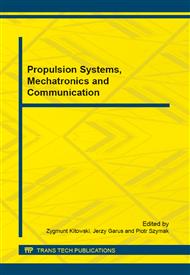[1]
Z. Hendzel, A. Burghardt, P. Gierlak, M. Szuster: Conventional and fuzzy force control in robotised machining, Solid State Phenomena 210 (2014) 178-185.
DOI: 10.4028/www.scientific.net/ssp.210.178
Google Scholar
[2]
P. Gierlak: Hybrid position/force control in robotised machining, Solid State Phenomena 210 (2014) 192-199.
DOI: 10.4028/www.scientific.net/ssp.210.192
Google Scholar
[3]
C. de Castelbajac, M. Ritou, S. Laporte, B. Furet, Monitoring of distributed defects on HSM spindle bearings, Applied Acoustics 77 (2014) 159–168.
DOI: 10.1016/j.apacoust.2013.07.008
Google Scholar
[4]
J.V. Abellan-Nebot, F.R. Subirón, A review of machining monitoring systems based on artificial intelligence process models, Int J Adv Manuf Technol 47 (2010) 237–257.
DOI: 10.1007/s00170-009-2191-8
Google Scholar
[5]
R. Teti., K. Jemielniak, G. O'Donnell, D. Dornfeld, Advanced monitoring of machining operations, CIRP Annals - Manufacturing Technology 59 (2010) 717–739.
DOI: 10.1016/j.cirp.2010.05.010
Google Scholar
[6]
K. Jemielniak, T. Urbański, J. Kossakowska, S. Bombiński, Tool condition monitoring based on numerous signal features, Int J Adv Manuf Technol 59 (2012) 73–81.
DOI: 10.1007/s00170-011-3504-2
Google Scholar
[7]
C. Shen, G. Wang, S. Wang, G. Liu, The Imbalance Source of Spindle-Tool System and Influence to Machine Vibration Characteristics, Digital Manufacturing and Automation (ICDMA), DOI 10. 1109/ICDMA. 2011. 317 (2011) 1288-1291.
DOI: 10.1109/icdma.2011.317
Google Scholar
[8]
T. Żabiński, T. Mączka, J. Kluska, M. Kusy, P. Gierlak, R. Hanus, S. Prucnal, J. Sęp, CNC Milling Tool Head Imbalance Prediction Using Computational Intelligence Methods, Lecture Notes in Artificial Intelligence LNAI 9119 (L. Rutkowski et al. Eds. ), Springer International Publishing Switzerland, Part I (2015).
DOI: 10.1007/978-3-319-19324-3_45
Google Scholar
[9]
C. H. Lauro, L.C. Brandão, D. Baldo, R.A. Reis, J.P. Davim, Monitoring and processing signal applied in machining processes – A review, Measurement 58 (2014) 73–86.
DOI: 10.1016/j.measurement.2014.08.035
Google Scholar
[10]
T. Żabiński, T. Mączka, J. Kluska, M. Kusy, Z. Hajduk, S. Prucnal, Failures Prediction in the Cold Forging Process Using Machine Learning Methods, Lecture Notes in Artificial Intelligence LNAI 8467 (L. Rutkowski, M. Korytkowski, R. Sherer, R. Tadeusiewicz, L.A. Zadeh, J. Zurada, Eds. ), Springer International Publishing Switzerland, Part I (2014).
DOI: 10.1007/978-3-319-07173-2_53
Google Scholar
[11]
ISO 1925: 2001 Mechanical vibration – Balancing – Vocabulary.
Google Scholar
[12]
G.T. Smith, Cutting tool technology: industrial handbook, Springer-Verlag London Limited, (2008).
Google Scholar
[13]
ISO 1940-1: 2003 Mechanical vibration - Balance quality requirements for rotors in a constant (rigid) state - Part 1: Specification and verification of balance tolerances.
DOI: 10.3403/30133096u
Google Scholar
[14]
R.R. Picard, R.D. Cook, Cross-Validation of Regression Models, Journal of the American Statistical Association 79 (1984) 575-583.
DOI: 10.1080/01621459.1984.10478083
Google Scholar
[15]
M.T. Hagan, H.B. Demuth, M.H. Beale, Neural Network Design, Boston, PWS Publishing, (1996).
Google Scholar


